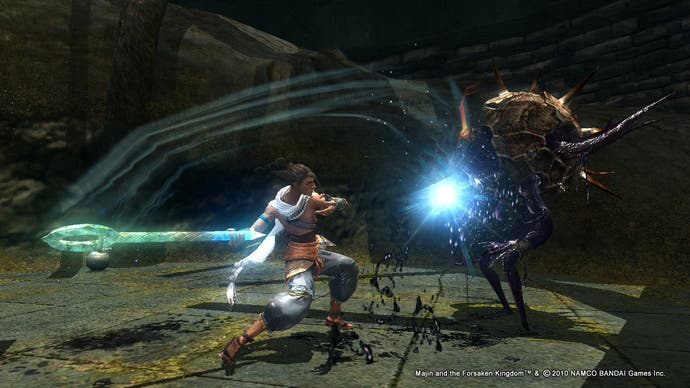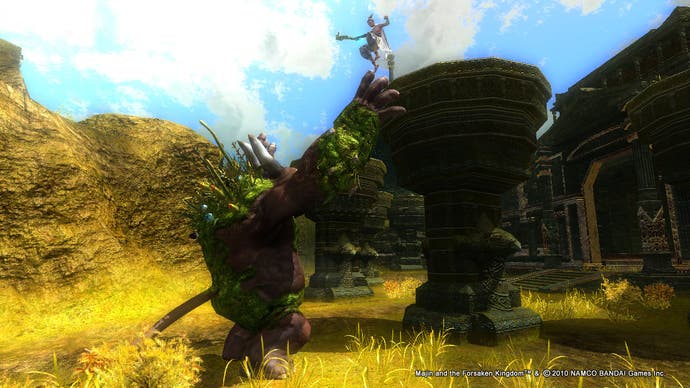Majin and the Forsaken Kingdom
It takes two.
Barcelona is a city of cpalm trees and distressed concrete; a city where hardcore religious mania has delivered on some top-quality joke architecture.
Half the place looks like Sarajevo filling in for LA on five minutes' notice, the other half suggests that Gaudi did his best work by inhaling a few bags of plaster of Paris and then sneezing on some whale bones.
It is, in other words, comfortably nestled amongst the great cities of the world. While Namco Bandai doesn't make a huge number of games here, you can understand why the publisher has chosen Barcelona as the venue to show off its new line-up.
And some of the games being demoed offer a similarly intriguing blend of styles. Majin and the Forsaken Kingdom is a particularly good example. Beyond the silhouettes and flickering lights of this Japanese fantasy's gentle scene setting, the action itself takes place in a bloom-ridden bucolic world of tumbledown castles and lush yellow grass.
The enemies, in contrast, are nasty little splodges of inky darkness, angry and angular. The heroes are Tupue, a spindly thief with a pineapple haircut, and the towering Majin, brutally powerful yet worryingly childlike: a rock-hewn monster who thuds through the dirt with the gaping lantern-jaw of Grover from Sesame Street, tiny amber eyes, and root vegetables sprouting out of his back.

Majin is built from combat and puzzles - though cynics might also observe it's built from Team Ico games and Zelda. It's probably best to put cynicism aside here, however: Game Republic's hardly the first developer to turn to Link for help, and members of Majin's development team previously worked on titles like Ico and Shadow of the Colossus.
Namco assures us that Majin's been in development long before Last Guardian was announced and, besides, there's something of Darksiders' approach to creative pinching here anyway. You sense the team is borrowing ideas because it cherishes them, rather than because it can't come up with any of its own, and you sense it loves the genre it's trying to become a part of.
Most importantly, Majin has plenty of its own character in the first place. Game Republic's previous title, Folklore, is far from perfect, but it's also very hard not to love. The game makes its presence felt with the beautiful and oddly Christmassy blasts of light that mark out the exhilarating combat, and the team seems to have more than enough ideas when it comes to creating unique puzzles based on this duo of mismatched heroes.

The story of Majin is pretty placeholder, however. In a land filling up with a mysterious darkness, an agile thief throws in with a lumbering, oddly vulnerable Majin to save the day. Friendships blossom, moves get unlocked, pressure switches are weighted down.
One of the things that gives this set-up an unusual force of impact, however, is that, despite his size, Majin is an innocent. His dialogue lines appear to have been written by whoever is currently the custodian of the Drunk Hulk Twitter account, but his Muppety features clash in interesting ways with his meaty arms and legs. While he's happy to take care of himself in battles, he needs the thief to guide him through the more complex levels one obstacle at a time.








